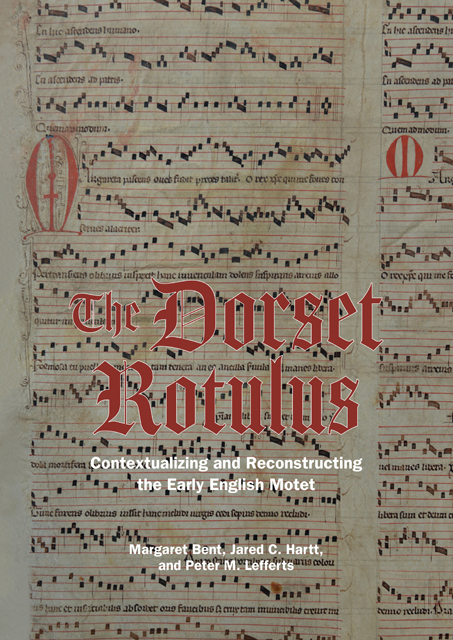Book contents
- Frontmatter
- Contents
- List of Figures
- List of Music Examples
- List of Tables
- Abbreviations
- Note on the Transcriptions
- Introduction
- 1 The Source and its Contents
- 2 Contexts and Designs
- 3 Voice-Exchange Motets and Ascendenti sonet geminacio/ Viri Galilei
- 4 Margareta pascens oves and its Large-Scale Comparands
- 5 Rota versatilis: Towards a Reconstruction
- 6 The Curious Case of Regina preminencie/ Gemma nitens/ … mater es intacta
- 7 Introducing Naufragantes visita/ Navigatrix inclita/ T. Aptatur/ … velox perpetrat
- 8 The Musical Rotulus: Artifact, Image, and Attributes
- 9 Epilogue: Conclusions and Speculation
- Appendix: Transcriptions, Texts, and Translations of the Four Dorset Motets
- Bibliography
- Index of Manuscripts
- Index of Musical Compositions
- General Index
- Studies in Medieval and Renaissance Music
5 - Rota versatilis: Towards a Reconstruction
Published online by Cambridge University Press: 14 January 2023
- Frontmatter
- Contents
- List of Figures
- List of Music Examples
- List of Tables
- Abbreviations
- Note on the Transcriptions
- Introduction
- 1 The Source and its Contents
- 2 Contexts and Designs
- 3 Voice-Exchange Motets and Ascendenti sonet geminacio/ Viri Galilei
- 4 Margareta pascens oves and its Large-Scale Comparands
- 5 Rota versatilis: Towards a Reconstruction
- 6 The Curious Case of Regina preminencie/ Gemma nitens/ … mater es intacta
- 7 Introducing Naufragantes visita/ Navigatrix inclita/ T. Aptatur/ … velox perpetrat
- 8 The Musical Rotulus: Artifact, Image, and Attributes
- 9 Epilogue: Conclusions and Speculation
- Appendix: Transcriptions, Texts, and Translations of the Four Dorset Motets
- Bibliography
- Index of Manuscripts
- Index of Musical Compositions
- General Index
- Studies in Medieval and Renaissance Music
Summary
The legend of St Katherine of Alexandria relates how the saint escaped unharmed from the wheel to which she was bound, while the wheel itself was fragmented and caused fatal injury to onlookers. The turning wheel of fate has wrought more mundane damage on the composition which forms the subject of this chapter – Rota versatilis – one of the most ingenious and ambitious of English compositions of the period c. 1300 and of all medieval musical offerings to this saint. The present revised version of an earlier article reconstructing this motet is included here because, on grounds stated in Chapters 1 and 4, we think it likely that it was once present in this rotulus. As a large-scale voice-exchange motet, it shares its form and many other features with the even longer Margareta pascens oves, together with which it appeared in another rotulus (Fountains), as detailed in Chapter 4. On the basis of what survives, Dor seems to have assembled some of the most ambitious large-scale compositions of its time; rotulus format is particularly well suited to notating in full large voice-exchange motets that could not easily be accommodated on one opening of a book, a point made in preceding chapters and in Chapter 8. Above all, Chapter 1 showed that devotion to St Katherine at Abbotsbury is well attested in three survivals: the dedication of St Catherine’s chapel there, the illustrations in the Abbotsbury breviary, and the seal of the fourteenth-century Abbot Walter de Stokes.
The temptation to present the material in the order of discovery is strong, but clarity will be better served by a brief description of the reconstructed composition. It is not a rota (a round canon at the unison), as the incipit might lead one to hope or expect (the first three sections begin with the words ‘Rota’, ‘Orbis’, and ‘Rota’), but a large-scale, five-section voice-exchange motet for two voices accompanied by a supporting pair of apparently freely composed tenors. It survives in two distinct versions in four different sources (three musical sources and one treatise on notation), all fragmentary, and the problems of determining its authentic form and rhythmic details arise from two particular considerations, both also with ‘round’ elements: these are the format of the sources, two of which were probably rotuli, and the notation, particularly the use of signa rotunda.
- Type
- Chapter
- Information
- The Dorset RotulusContextualizing and Reconstructing the Early English Motet, pp. 175 - 212Publisher: Boydell & BrewerPrint publication year: 2021



